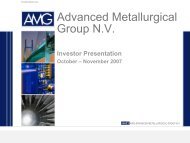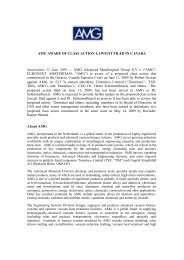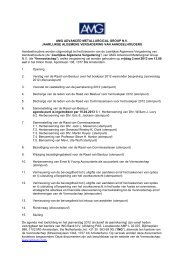Quasi-mono Silicon: The best of both worlds
Quasi-mono Silicon: The best of both worlds
Quasi-mono Silicon: The best of both worlds
You also want an ePaper? Increase the reach of your titles
YUMPU automatically turns print PDFs into web optimized ePapers that Google loves.
Reprinted from<br />
www. SolarNovus.com<br />
<strong>Quasi</strong>-<strong>mono</strong> <strong>Silicon</strong>: <strong>The</strong> <strong>best</strong> <strong>of</strong> <strong>both</strong> <strong>worlds</strong><br />
By Nadya Anscombe, Solar Novus Today Contributing Editor-UK<br />
<strong>The</strong>re was a time when the crystalline silicon solar cell industry could be<br />
separated neatly into two camps –multi-crystalline and <strong>mono</strong>crystalline. But<br />
today a new technology blurs those boundaries, but no one is quite sure what to<br />
call it: quasi-<strong>mono</strong>crystalline, nearly-<strong>mono</strong>, cast<strong>mono</strong>, <strong>mono</strong>cast. <strong>The</strong> fact is that<br />
it lies somewhere in between multi-crystalline and <strong>mono</strong>crystalline.<br />
<strong>The</strong> technology, which we’ll call quasi-<strong>mono</strong>, seems almost too good to be true. It<br />
may allow multi-crystalline cell manufacturers to increase the efficiency <strong>of</strong> their<br />
cells for a small cost; and it <strong>of</strong>fers <strong>mono</strong>-crystalline cell manufacturers the<br />
opportunity to manufacture their high-efficiency cells at considerably lower cost.<br />
<strong>The</strong> basic idea behind quasi-<strong>mono</strong> is that a<br />
casting process is used instead <strong>of</strong> the slow and<br />
expensive Czochralski process (CZ) to<br />
manufacture <strong>mono</strong>crystalline ingots. <strong>The</strong><br />
process is similar to that used for multicrystalline<br />
wafers with two key differences: a<br />
<strong>mono</strong>crystalline wafer is used as a seed at the<br />
bottom <strong>of</strong> the crucible; and the temperature<br />
is carefully controlled.<br />
“With careful control <strong>of</strong> the vertical temperature gradient, the solidifying ingot<br />
will take up the crystal orientation <strong>of</strong> the seed wafer,” explains says Nigel Mason,<br />
from UK-based PV Consulting. “This process not only gives an ingot that is largely<br />
<strong>mono</strong>crystalline, it also produces a square wafer, unlike the traditional <strong>mono</strong><br />
process which typically gives a wafer with rounded corners resulting in reduced<br />
active area in the module.”<br />
Reprinted from<br />
“With a relatively small<br />
investment to retr<strong>of</strong>it their<br />
current furnaces they can<br />
manufacture wafers<br />
closer in performance to<br />
conventional CZ<br />
<strong>mono</strong>crystalline wafers at<br />
a cost close to multicrystalline<br />
wafers.”
Gen5 Mono² ingot cross section (bricks)<br />
<strong>The</strong> idea for the quasi-<strong>mono</strong> technology is not new, but market conditions kept it<br />
in the lab for many years. But its advantages are just too good to resist for many<br />
solar cell manufacturers and the technology is coming quickly to market. <strong>The</strong> last<br />
twelve months has seen a plethora <strong>of</strong> announcements including Chinese<br />
companies ReneSola and JA Solar, German companies Q-Cells, Schmid and<br />
Schott, US company Tech Precision, US furnace manufacturer GT Solar and Dutch<br />
metals company AMG IdealCast.<br />
Many more companies, especially in China,<br />
have their own version <strong>of</strong> a quasi-<strong>mono</strong><br />
process. With so many companies using<br />
similar ideas, it’s surprising that no major<br />
patent disputes have ensued and the<br />
technology has been allowed to proliferate.<br />
AMG IdealCast was recently awarded a US<br />
patent, which the company claims covers<br />
the process for manufacturing the quasi<strong>mono</strong><br />
material process. <strong>The</strong> company<br />
bought the technology, called Mono 2 , from<br />
BP Solar in 2010. “Over the last two years,<br />
we have optimized the Mono 2 technology<br />
utilizing our ALD SCU furnace,” explains<br />
Roger Clark, Chief Operating Officer <strong>of</strong> AMG IdealCast. “We are continuing to<br />
monitor the marketplace to see if any company is infringing upon our patent. We<br />
also have four additional supporting patents pending in the US and other<br />
important solar jurisdictions.”<br />
Competitor GT Solar is confident that its technology does not infringe any<br />
patents.<br />
Henry Chou, GT’s product marketing manager for PV crystal growth systems, said<br />
that the company has been working on its Monocast for more than six years, and<br />
Reprinted from<br />
Mono² ingot seed plate after it has been<br />
cut from the bottom <strong>of</strong> the ingot and<br />
etched---ready to use for next Mono²<br />
ingot
efforts intensified in 2010 when GT Solar bought Crystal System and brought its<br />
founder, Fred Schmid, on board. Chou noted that, “We have now scaled up to a<br />
level where production can happen in volume.”<br />
Chinese company JA Solar is already producing its Maple quasi-<strong>mono</strong> solar cells in<br />
volume and has reached an average conversion efficiency <strong>of</strong> 18%, which the<br />
company claims is a new record for JA Solar, and they noted it that the industry<br />
standard average conversion efficiency for multi-crystalline solar cells is<br />
approximately 16.8%.<br />
Panorama view <strong>of</strong> Frederick seed plate pilot line for customer demonstrations<br />
With these increases in efficiencies, which are similar to those claimed by GT,<br />
AMG and other quasi-<strong>mono</strong> developers, the interest in the market is<br />
understandable. However, switching to quasi-<strong>mono</strong> is not without challenges,<br />
especially for the large integrated solar cell manufacturers. “When you grow a<br />
quasi-<strong>mono</strong> ingot, it will be <strong>mono</strong>crystalline at the base and in the centre, but at<br />
the sides it exhibits multi-crystalline properties,” explains PV Consulting’s Nigel<br />
Mason. “When the ingot is cut into bricks you can end up with two, or sometimes<br />
three, types <strong>of</strong> crystal structure; <strong>mono</strong>, multi and a mix <strong>of</strong> the two. Cell<br />
manufacturers then have to decide how <strong>best</strong> to process these wafers. If their<br />
production line is set up to etch multi-crystalline wafers, then it will not be the<br />
optimum for <strong>mono</strong>crystalline wafers and some <strong>of</strong> the cell efficiency gain from the<br />
casting process could be lost.”<br />
But for companies that supply wafers to the solar industry, the figures speak for<br />
themselves. With a relatively small investment to retr<strong>of</strong>it their current furnaces<br />
they can manufacture wafers closer in performance to conventional CZ<br />
<strong>mono</strong>crystalline wafers at a cost close to multi-crystalline wafers. Roger Clark<br />
explains: “<strong>The</strong>re are no industry-accepted standards, so cost comparison is<br />
difficult, but we estimate that, with a polysilicon feedstock price <strong>of</strong> $30/kg, our<br />
customers can achieve a savings <strong>of</strong> $0.45/wafer which equates to $0.11/W when<br />
compared with conventional <strong>mono</strong> wafers <strong>of</strong> a similar conversion efficiency.”<br />
Reprinted from
AMG IdealCast and GT Solar and several other companies are ready to take their<br />
technology to market. It remains to be seen if this traditionally cautious and cashstrapped<br />
market will have the resources to invest in this new technology.<br />
Additional <strong>Quasi</strong>-Mono Technical Information<br />
<strong>Quasi</strong>-<strong>mono</strong> <strong>Silicon</strong>: Processing wafers from ingots to cells<br />
Each Mono 2TM ingot (representing the entire ingot produced by the ALD-SCU Gen<br />
5 furnace) is cut into 25 bricks in a 5 x 5 array illustrated in the schematic shown<br />
here. All <strong>of</strong> the bricks are converted into wafers using a wire saw and all <strong>of</strong> the<br />
wafers are then used for solar cell production. Every Mono 2 ingot has four bricks<br />
at each corner that are called “corner bricks” and typically have <strong>both</strong> multicrystalline<br />
and <strong>mono</strong>-crystalline areas. Mass ingot yields (brick mass/ingot mass)<br />
are at least as good as any casting method in today’s market.<br />
Corner brick cell process texture comparison<br />
<strong>The</strong> image shown above is a composite photograph <strong>of</strong> four different solar cells,<br />
each made from wafers cut from a corner brick. <strong>The</strong> composite photograph<br />
illustrates the effectiveness <strong>of</strong> different texture etches that are industry standard<br />
Reprinted from
production methods currently in use for <strong>mono</strong>-crystalline and multi-crystalline<br />
cell manufacturing.<br />
NaOH: IPA --- solution <strong>of</strong> sodium hydroxide, isopropyl alcohol and water,<br />
commonly called “caustic”.<br />
KOH: IPA--- solution <strong>of</strong> potassium hydroxide, isopropyl alcohol and water, also<br />
called “caustic”<br />
ICT --- solution <strong>of</strong> acids such as: nitric acid, hydr<strong>of</strong>luoric acid and water, it is called<br />
ICT for the acronym Iso Chemical Texture§<br />
<strong>The</strong> current industry standard for multi-crystalline wafers-to-cell processing use<br />
ICT methods and the standard <strong>mono</strong>crystalline cell processing production lines<br />
use KOH etching methods.<br />
In summary: <strong>The</strong> entire Mono 2 yielded ingot mass is effective for cell<br />
production. Sorting is used to separate the <strong>mono</strong> wafers and multi wafers and<br />
different industry standard etching methods are used to achieve highest cell<br />
efficiencies and maximum economic benefit from Mono 2 ingots. No additional<br />
costs or technology modifications are required to process wafers from Mono 2<br />
ingots into cells.<br />
ICT is the <strong>best</strong> solution for wafers cut from corner bricks because from a module<br />
manufacturer’s point <strong>of</strong> view, a cell that does not have optical differences across<br />
the front surface <strong>of</strong> the cell or from cell to cell is <strong>best</strong> for its cosmetics.<br />
Copyright © 2012 Novus Media Today, LLC. All Rights Reserved.<br />
Reprinted from







